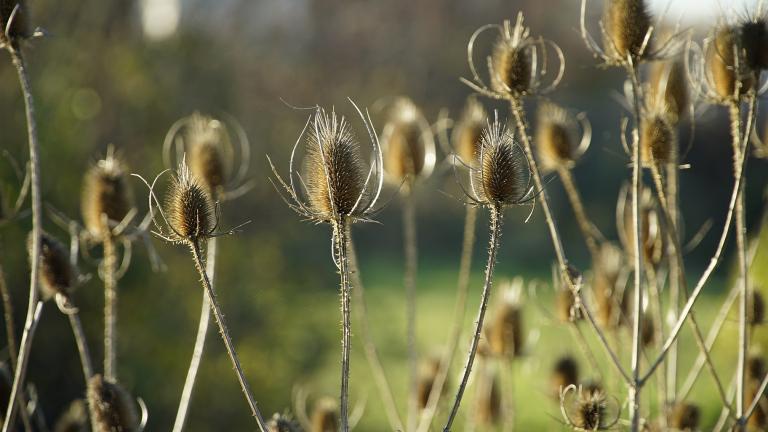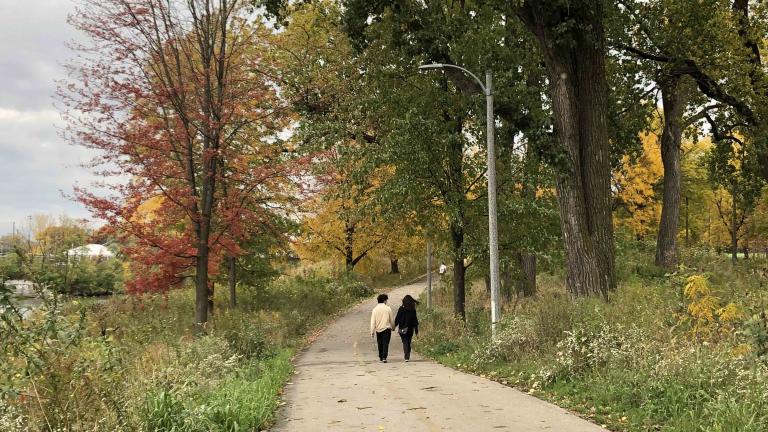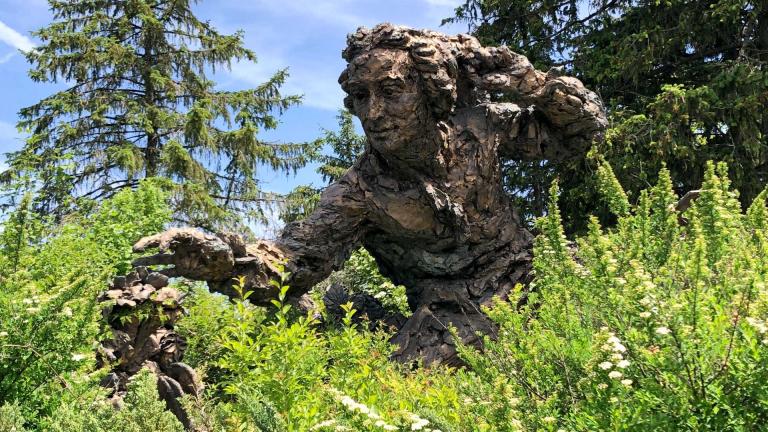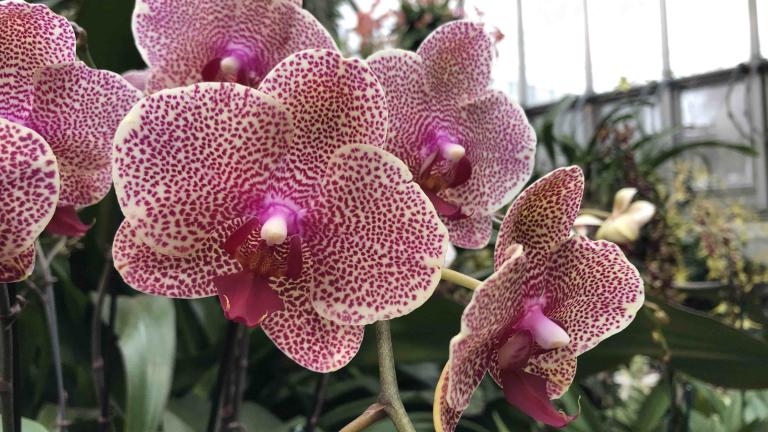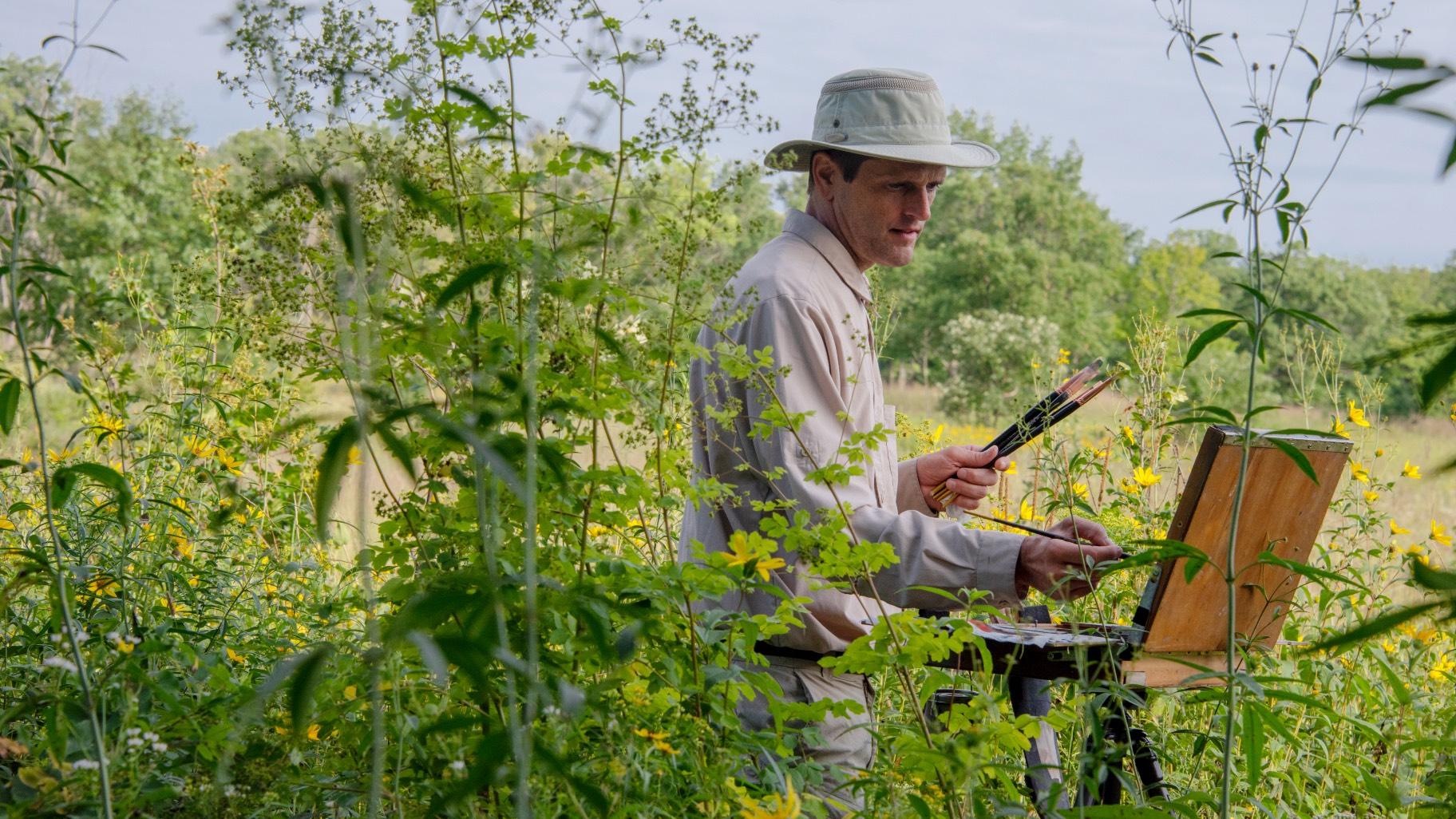 Artist Philip Juras painting at Somme Prairie Grove in Cook County. (Credit Robin Carlson)
Artist Philip Juras painting at Somme Prairie Grove in Cook County. (Credit Robin Carlson)
Sky above, an ocean of grasses rippling in all directions and nothing to break the line of the horizon as far as the eye could see. That was the Illinois prairie, equal parts majestic and terrifying, when first encountered by early European settlers.
Then the plows came.
By the late 1970s/early ‘80s when a teenaged Philip Juras road-tripped through the state, all he saw from the highway was mile after mile of corn and soybeans speeding past his car window.
“I thought that’s what prairie was. And I expect that’s what a lot of people think prairie means,” said Juras. “That’s the modern prairie, I guess.”
But what of Illinois’ historic landscape? While those immense, wide-open spaces have long since vanished, remnants exist, scattered like whispers on acreage that either stubbornly defied cultivation or has been reclaimed by conservationists.
Between 2013 and 2019, Juras, now an accomplished artist, chased those ghosts across the state, from Cave Creek Glade Preserve in Johnson County near the southern border to Spring Lake Preserve in northwestern Cook County. The result is an exhibit of paintings, “Picturing the Prairie,” on display at the Chicago Botanic Garden through mid-September. (There’s also a companion book.)
“I have gotten the sense that people don’t think of Illinois as a nature destination,” said Juras, who hails from Georgia but claims Midwestern roots courtesy of his mom, who was born and raised in the Prairie State. “To be honest, things are far flung, and the preserves are small, but it is there and it’s really great stuff. It’s worth getting out to find.”
 Beaver Pond, Nachusa Grasslands. Beavers were reintroduced to Illinois in the 1930s after being nearly extirpated and are now found in every county. (Credit Philip Juras)
Beaver Pond, Nachusa Grasslands. Beavers were reintroduced to Illinois in the 1930s after being nearly extirpated and are now found in every county. (Credit Philip Juras)
Though Juras considers himself an artist first, he’s also a landscape architect. As he was working toward his graduate degree in the latter, a research project brought him under the spell of grasslands.
One wouldn’t know to look at the southeastern United States today, but the area was historically covered in grasslands before being supplanted by forests.
“That intrigued me,” Juras said. “As a painter, I really got drawn to that aesthetic.”
He finds grasslands’ sense of space and distance alluring, but also the textures, he said, be it blades of grass backlit by the sun or a wave of deeper colored green, suggesting the presence of a wetland.
Juras made the leap in terms of subject matter from the South to Illinois at the suggestion of conservation advocate Wendy Paulson, an Openlands board member among other affiliations, who was familiar with his grassland paintings. On her invitation, he visited prairie restorations in Cook County and was immediately enthralled.
“Part of our culture is entwined around the idea of wilderness. I think it is essentially a romantic impulse, which certainly I recognize that in myself,” Juras said.
That initial introduction led to further exploration of prairies, almost exclusively in Illinois, with the occasional foray into Indiana and Wisconsin. Juras estimates he made at least a dozen trips from his home in Athens, Georgia, to the Midwest to meet with experts in prairie restoration and spend time at sites.
Prairie, as it exists today, encompasses a continuum of landscapes, from wetlands to oak savannahs to sandy hilltops, Juras discovered.
“In southern Illinois, you’re transitioning into the more forested ecosystem of the mid-south hardwood forest that would begin in Kentucky and Tennessee, still with grassland, but not the big giant open spaces that I think anyone would think of when you hear the word prairie,” he said.
“Coming further north into the glaciated areas of Illinois, you get these broad flat uplands — that’s where those spaces were, where early chroniclers wrote about not being able to see a tree in any direction around them. They’re long gone because that was also the most productive soil. The ones that hung on were the ones on sand dunes, steep slopes or gravel hills. Those are places where you can still see actual prairie species in their original position.”
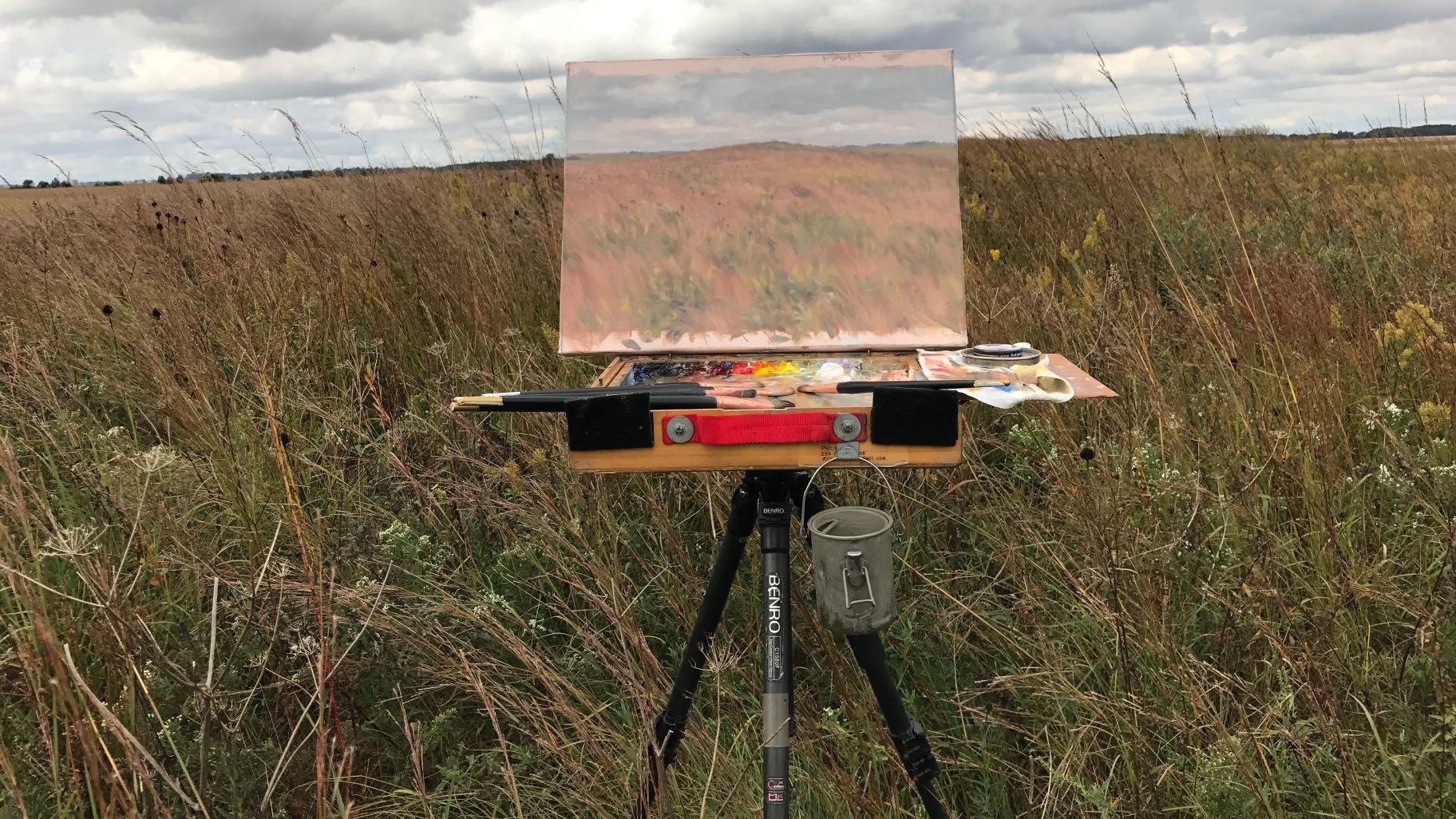 Using portable gear, artist Philip Juras creates field study sketches to capture rough details on site, which will be used to inform a more detailed, larger painting completed in his Georgia studio. (Credit Philip Juras)
Using portable gear, artist Philip Juras creates field study sketches to capture rough details on site, which will be used to inform a more detailed, larger painting completed in his Georgia studio. (Credit Philip Juras)
The goal of Juras as an artist is to place the viewer inside the scene. One of the ways he achieves that is by placing himself there first, physically, painting on-site.
For the prairie series, Juras would haul his portable gear to a preserve and create a rough oil sketch, approximating colors, lighting and the position of any wildlife or landmarks. He augmented these field sketches — a number of which are included in the exhibit — with photographs, but the process of painting on-site was key to the finished piece.
The human eye does a better job of filtering out visual “noise” and finding a focal point than a camera, which takes in everything, Juras explained.
“In those field paintings you have been attracted to something for its aesthetic importance, it stands out in the landscape,” he said. “There’s some arrangement or composition or whatever it is, but it doesn’t necessarily look like much in the camera. You observe it and you translate it directly through your hand to canvas.”
He paints quickly on-site, competing against the setting sun or shifting weather conditions. Back in his Athens studio, Juras uses the field sketch as reference for the larger work, adding in detail and subtleties. A stroke of purple will become a recognizable coneflower, a slash of brown a bison.
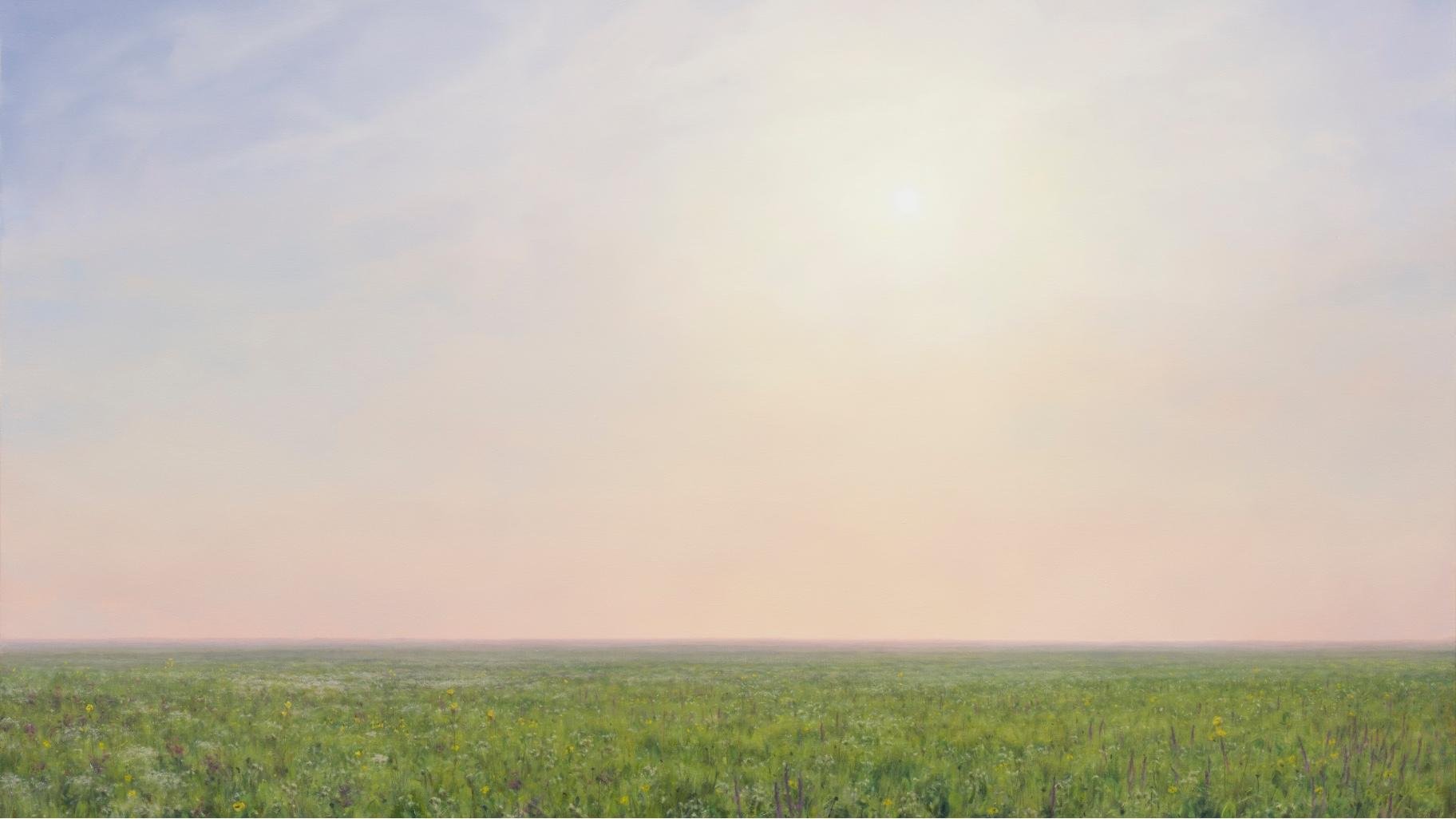 "Late Afternoon on the Grand Prairie of Illinois c. 1491" (Credit Philip Juras)
"Late Afternoon on the Grand Prairie of Illinois c. 1491" (Credit Philip Juras)
And yes, artistic license does come into play, from minor enhancements, like maybe making a cloud formation more interesting than it actually was, to complete works of what could be best described as historical fiction.
“I sort of think in historical terms even though I’m looking at a modern landscape,” Juras said. “I almost see the historical prairie, or I imagine it, onto whatever I’m looking at.”
For one of the paintings in the series, he took that concept to its ultimate conclusion: a recreation of pre-European settlement, the grand prairie of Illinois.
“In that landscape, there wouldn’t have been anything to rest your eye on, no focal point, and no compositional elements at all. Simply the horizon line as a horizontal element and a fairly featureless landscape, with a great deal of diversity in color, but not physical diversity or structural diversity,” Juras said.
The result, “Late Afternoon on the Grand Prairie of Illinois c. 1491,” draws on Juras’ research and pulls in elements from his various field studies. It’s a sparse piece, evoking a sense of smallness and isolation, and Juras said he worried “it would be an odd one out” in the exhibit.
Having traveled to the Chicago Botanic Garden for the show’s opening in May, Juras surreptitiously spied on visitors as they viewed his paintings and was pleased to see that his grand prairie experiment was meeting with strongly positive reactions.
“It has a very different quality where it’s meditative,” he said. “If you read the (exhibit) label, you can think about it as a sort of historical painting but all by itself it seems to grab people in that sort of minimalist way.”
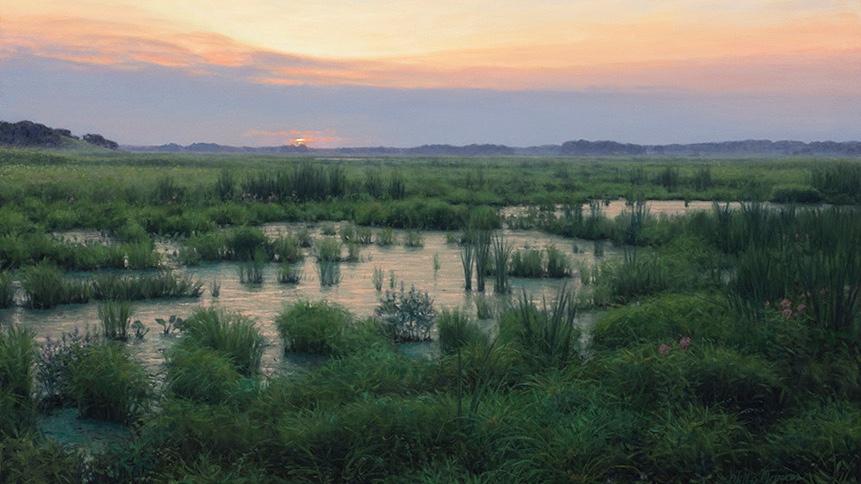 Spring Lake Preserve, Cook County. To help the viewer step into the scene, artist Philip Juras typically incorporates vegetation into a painting's foreground, and then elements gradually grow hazier and more distant. (Credit Philip Juras)
Spring Lake Preserve, Cook County. To help the viewer step into the scene, artist Philip Juras typically incorporates vegetation into a painting's foreground, and then elements gradually grow hazier and more distant. (Credit Philip Juras)
Through “Picturing the Prairie,” Juras hopes to not only pique people’s interest in prairies, but in their restoration. The remnants depicted in his paintings represent 0.01% of the original ecosystem, and those fragments require ongoing management.
“To be honest, there’s actually no such thing as a prairie remnant, a perfectly natural prairie remnant, because all remnants of the prairie have been restored to some degree. Without human intervention, they go away in Illinois,” he said, whether shaded out by trees or choked by invasive species.
But in some ways, Juras said, a 35-year-old restored remnant that could be mistaken for the 1,000-year-old real deal is every bit as amazing as the grand prairie of legend.
“It’s a sort of hopeful scenario,” he said, “that given time and dedication and expertise, the prairie ecosystem is actually something that can be restored.”
“Picturing the Prairie” is a partnership of the Chicago Botanic Garden, the Field Museum, the Forest Preserves of Cook County, the Nature Conservancy and Openlands. Openlands’ Get Outside Map has details on prairie locations throughout the region for those who want to experience the landscape up close.
Contact Patty Wetli: @pattywetli | (773) 509-5623 | [email protected]



